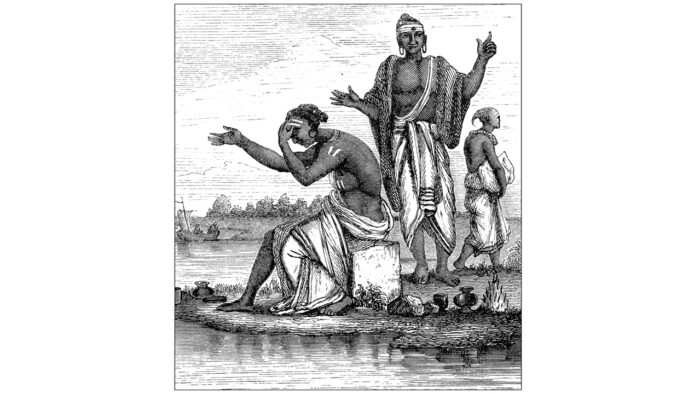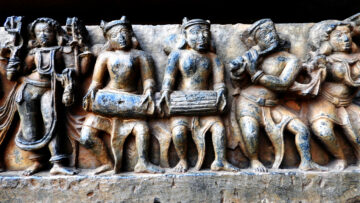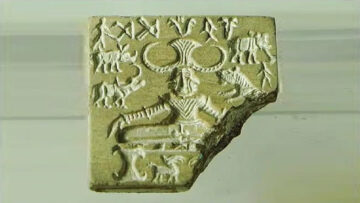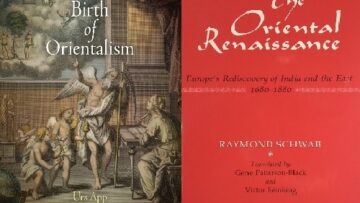Introduction
This article is a response to and a collection of arguments against Sheldon Pollock’s claims in his article ”Deep Orientalism? Notes on Sanskrit and Power Beyond the Raj (1993)”. Pollock is an Indologist who has been well known among academic circles (especially in the field of Sanskrit studies and Indology for centuries), but with the advent of social media, his notoriety has grown and so has his reputation as a controversial scholar.
Even though this article is old, the combination of topics and issues he raises (caste, Aryan/Unaryan divide, Orientalism, Brahmanism) is heavily researched and hotly debated in Indology and South Asian studies, as well as among the general public in India. That is the reason why this article was chosen to respond to.
Colonialism, the Power-knowledge Nexus and European Indology
In this article, Pollock starts with the question of, to what degree were the European scholarship of Asia and the colonial domination of Asia mutually constitutive? Pollock begins his article by briefly touching upon ‘the constructionist thesis’ that many post colonial Indologists subscribe to. This thesis states that the generic descriptions of Hinduism one commonly encounters in textbooks, brochures and documentaries about India (Hinduism is a religion with many gods, it has a caste system, brahmins are the priestly class etc) is a construction of Europe, rather than describe any reality in India. However, exactly what is being constructed, and how it got constructed is a subject of much debate among scholars. The hypothesis that the European descriptions of not only India but other non-Western cultures, are merely constructs, was originally put forward by the Palestinian scholar Edward Said. He claimed that the European writings about the Orient, rather than providing us with a ”true” description of the Orient, constructs an Orient that exists in the Western mind, her books, universities, and libraries. Edward Said refers to this phenomenon as Orientalism.
Said also claimed that the colonizer-colonized relationship that Europe had with Orient/Asia played a pivotal role in European knowledge production about the Orient/India. In other words, the relationship of power that Europe had over the Orient determined its description of the Orient. This knowledge-power nexus hypothesis can be divided into three main components:
1) Orientalism/Indology as a tool to administer and rule over India: The British commissioned studies and population censuses of India (which categorized the Indian population by religion, caste) etc) so that they can have basic information about their subjects.
2) Orientalism/Indology as a product of colonialism: Europe was able to make India and the Orient into an object and field of study, precisely because they had colonized and had established hegemony over the Orient. Moreover, the British could represent and write about India as they saw and experienced India, while the native experience of their own culture was denied and distorted.
3) Said and other postcolonial thinkers also saw Orientalism as a discourse used to justify the relationship of hegemony and dominance that the West had over Asia. For example, many of the British administrators and intellectuals presented the British rule of India as a civilizing mission that benefited the Indians.
In addition to the knowledge-power nexus, some of the modern day post-colonial scholars that subscribe to the constructionist hypothesis, also claim that the nineteenth century Orientalists systematized Europe’s knowledge about India by assuming that the key to understanding Indic religion was to study the ancient Indic texts, and looking for textual foundations for the practices they observed. Postcolonial scholars speculated that the Orientalist grounding of Indian traditions in texts, was guided by a Christian conception of religion in which scripture becomes the key to understanding any religion.
The Power-knowledge Nexus and German Orientalism
Pollock rightly points out that Said’s hypothesis of Orientalism being the product of colonial power doesn’t explain German Indology. Germany never had colonies in India and yet the Indological productions of German Orientalists surpassed that of the rest of Europe.
However, Pollock still retains the power-knowledge hypothesis when it comes to German Orientalism. German Indology served the interests of the nineteenth century German empire as well as the Nazi regime, in their quest to be the dominant power in Europe. The discovery of the antiquity of Sanskrit, as well as the relationship between Sanskrit and European languages, was used by many German intellectuals as evidence that the ancient Indians were the primordial nation from which Europeans themselves descended (the Aryans). Germans were thought to be the closest descendants of the so-called Aryan race.
With the advent of racial science, biological racial purity was added to the religious and cultural purity of the so-called Aryan race. Although the topic of race science and its incorporation into Nazi ideology is a huge topic which is beyond the scope of this article, suffice to say that the idea of the Aryan master race, the racial kinship between Germans and the ancient Indian Aryans, and the degeneracy of the current Indian Aryans (having fallen into barbarism and biological impurity) became important components of Nazi racial ideology. Needless to say, nineteenth and twentieth century Indology partially provided the planks on which the laws and policies of the Nazi state were established. The ancient Aryas of India were thought to have established the superiority of their race, culture and religion over the indigenous populations, but later degenerated culturally and biologically by mixing with the host populations. The Varnashrama dharma outlined in many Indian texts were thought to be laws to preserve the racial and cultural purity of the Aryan race.
Many of the Nazi Indologists saw Germans as the purest descendants of the Aryans, both racially and culturally. Indology was thought to help the German nation realize its goals and destiny as the master race.
The Usefulness of the power-knowledge nexus in analyzing Orientalist discourse
The problem with the power-knowledge nexus hypothesis is that the fundamental conceptual structure of Indology and Orientalism was formed long before the advent of colonialism and German imperialism and even precedes the Protestant Reformation. For example, the idea of a pure proto-Christian Indian religion predates the Protestant reformation and goes back to the early Church fathers who thought of the brahmins as possessors and propagators of the true proto-Christian religion. This proto-Christian religion was seen as the true pure religion, the original revelation of the Biblical God that later degenerated into idolatry.
When Europeans first arrived on Indian shores, many of them thought that the Indian religion (later called Hinduism) was one such corruption of a pure monotheistic proto-Christianity. Brahmins were seen by both, Catholic and Protestant missionaries as an immoral priesthood who had corrupted the true religion. These missionaries constructed the basic outline of a unified Hindu religion when confronted with a plurality of traditions in India (Vedas as the revelation, Sastras and Smritis and laws and doctrines). For example, the French Jesuit missionary, Jean Bouchet thought that the Puranas and Itihasas contained themes from the Bible; Brahma was actually Abraham etc. The Biblical God had engraved the true religion in the hearts of all men, but later this truth became hidden and lost. The textualization of Indian traditions that the post colonial scholars criticized the Orientalists of doing, was already being done by Jean Bouchet in the first half of the eighteenth century.
Similarly, the basic framework of German and Nazi Indology precedes the nineteenth century. The notion of the Aryan/Indo-European race was a product of centuries of Christian history and anthropology. Since the Middle Ages, Christian Europe saw non-Christian traditions as corruptions or degeneration of the original proto-Christian religion mentioned before. The primordial nation to whom God’s revelation was gifted was thought to be the chosen elect, possessing the most virtuous qualities, having acquired them unsullied from Adam through Noah, uncorrupted by idolatry.
In the Middle Ages, the descendants of Japheth (one of the three sons of Noah) were thought to be this pure unsullied race, and many groups from different European kingdoms either claimed superiority or justified their privileged position by positioning their lineage as closely as possible to the Japhetic line. It was thought that the pure Proto-Christian religion survived in the Japhetic line.
With the discovery of the relationship between Sanskrit and the European languages the notion of an Aryan race was born, and the Aryan race was thought to be this primordial nation, and there were feverish attempts by German and other Orientalists to locate the Indo-European homeland and religion. Even though it was German Indology, more than French or British Indology, that latched on and fleshed out the idea of an Aryan race and homeland, the intellectual foundations of the Aryan concept were laid centuries before either colonialism or Nazism.
The bottom line is that the claim that Orientalism and Indology arose from and was determined by the power relations between the West and Asia, or that it arose and developed within Germany as a tool for a European regime to provide intellectual justification of their dominance within Europe, simply does not hold water. Rather, the European descriptions of India are a result of how Europeans experienced India, which in turn was structured by centuries of Christian theology.
Pre Colonial Orientalism?
In the section of his article titled ”Pre Colonial Orientalism?”, Sheldon Pollock claims that just as the British and German empires used Orientalism to justify their imperialism, the brahmins of precolonial India engaged in their own form of Orientalism to defend their privileged position in society.
Pollock begins this section by stating the position of many postcolonial scholars regarding the effects of colonialism on restructuring Indian society, particularly when it comes to caste, and then proceeds to challenge this position. A common claim among post colonial Indologists is that the construction of Hinduism was effected through dialogue between the colonizer and the brahmins, the so called elite of Indian society. Since the brahmins were the priests of the Hindu religion, the colonizers relied on them to learn about Hinduism. They even based their census classifications and structured their legal systems (e.g. Hindu law in British India) based on the information they got from the brahmin elites. The end result according to these post colonial Indologists, was that British colonialism ”in cooperation with orientalism, “traditionalized” society in such a way that it took on a form, a hegemonic Sanskritized form” (Pollock, 1993, p. 97). Brahmanical texts, which were used to settle matters and disputes that fell under the purview of Hindu law, suddenly acquired an authority within local traditions they never had before. This resulted in the artificial Brahmanization of society, in which the values of the brahmin elite got imposed on the rest of the populace.
Sheldon Pollock challenges this by claiming that texts like the Dharmashastra and Manusmriti were used by the brahmins to create precolonial legal systems, and justify and solidify their hegemonic position in Indian society as the priestly elite. Thus, for Pollock, this Brahmanization of society mentioned earlier, was happening prior to British colonialism through the priestly and ruling elites. Pollock refers to this as a precolonial form of Orientalism.
The first question that arises from Pollock’s hypothesis is: How is this a form of Orientalism? Orientalism refers to the body of writings and descriptions that the West produced about Asia. Even if one assumes Pollock’s claims about brahmins using Dharmasastras to create precolonial legal systems was true, how is this a form of Orientalism?
I do not wish to enter into the debate on whether or not British colonialism created and/or solidified a preexisting caste system, and affected a Brahmanization of Indian society. That is another topic altogether. What I do wish to engage with and challenge is Pollock’s claim of a precolonial hegemonic Brahmanical social order centered around Varna
Sheldon Pollock uses the following concepts or ideas to support his argument:
1) The supposed oppressed position of women in the Vedas and Dharmasastras.
2) The concept of varnashramadharma.
3) The Aryan/Mleccha/Unarya/Dasa divide is found in the above-mentioned Vedas and Dharmasastras.
4) And finally, the idea that the Vedas and Dharmasastras themselves are religio-legal texts that were created and used by brahmins to impose a social order on the rest of the population.
It is worth noting that these are the ideas that are claimed to be foundational for the varna/caste system by everyone from Orientalists and missionaries of yesteryear, to Indologists and social activists of today.
One of the examples he uses is the twelfth-century text known as the Krtyakalpataru of Laksmidhara. Pollock points to a discussion about sahamarana (sati) that takes place in the context of vyavahara, and interprets vyavahara as juridical procedure and substantive law. He quotes Laksmidhara, who states that all women, except for those who are pregnant or have small children are entitled to die with their husbands. There are a number of claims to address here. Firstly, Laksmidhara doesn’t claim that women are morally obligated to commit Sati when he says they are entitled to die with their husbands. Sati is presented as one of the options that a woman can undertake. There are other sastras that recommend remarriage for a widowed woman. But the main problem with Sheldon Pollock’s statement is his interpretation of vyavahara as juridical procedure and law. On what basis does he interpret vyavahara as law? This problem of equivocating Indic terms and concepts with law, and Sastras as legal texts is compounded in Sheldon Pollock’s interpretation of varnashramadharma.
According to Pollock, Varnashramadharma refers to a social order based on hierarchical stratification with brahmins at the top, and the shudras at the bottom. He quotes a verse from the beginning of the Valmiki Ramayana as an exemplar of the varnashramadharma:
”ksatrambrahmamukhamcasidvaisyahksatramanuvratah/
Sudrahsvakarmaniratas trin varnanupacarinah//”
(The ksatriya order followed the lead of brahman order, the vaisya that of the ksatriya, whereas the sudras, of proper duties, served the other)
Pollock interprets this as a socio-religious hierarchy and points out that this is the same varnashramadharma that is promulgated by the Sastras too. He is not clear up to what extent this varnashramadhara was a real phenomenon, as opposed to a social ideal. On one hand, he refers to it as an ideal of a social order, and at the same time, talks about it as if it was a real social phenomenon.
Leaving that aside, neither Pollock nor other scholars have been able to adequately address some fundamental anomalies confronting their account of the caste system. Firstly, nobody has been able to show that a varna system existed at any point in Indian history. Secondly, assuming such a system existed, how were brahmins able to impose this system on the rest of the populace? Even a cursory examination of Indian history shows that brahmins did not have the kind of institutional power and authority to impose any sort of legal framework or caste system on the rest of the Indian society. In fact, Sheldon Pollock himself admits the failure of Indology to ”trace with any adequacy a historical map of social power in traditional India” (Pollock, 1993, p. 104). And yet, that doesn’t prevent him from pontificating about brahmin hegemony.
Even more fundamentally, on what basis can Pollock interpret the Dharmasastras as legal texts? The term and concept ‘law’ has precise meanings attached to it, which have developed over the centuries in Western thought; not only in the Western legal tradition, but also philosophy and Christian theology, both of which have been linked to the legal domain for much of European history. The same considerations apply to terms like ‘dharma’ and ‘vyavahara’, and the role they play in the Indian intellectual traditions. One needs to do focused multidisciplinary comparative research that explores the history and development of both Western legal thought as well as the Sastra tradition, before one equates dharma and vyavahara with law. Finally, speaking of the supposed hierarchy expressed in the Dharmasastras, brahmins have as many restrictions placed upon them as so-called privileges; much more so than shudras. Looked at from this perspective, brahmins become the worst off class upon which the highest number of restrictions are placed upon.
In addition, Sheldon Pollock also claims that brahmins effectively created a monopolization of knowledge, preventing the shudras from learning Sanskrit/and reading the Sanskrit based religious legal texts like Vedas and Sastras. Once again, where is the evidence for this? Some passages from the Manusmriti or some other Dharmasastras that ‘forbid’ shudras from reading the Veda won’t do. After all, it is far from settled whether or not these were legal statutes. Moreover, why would the brahmins prevent others from reading Sanskrit or the Vedas? In the middle ages, the Church alone could read, understand, and interpret the Bible, because it was the revelation of God’s plan. If the laity were allowed to read it, there is a danger of misunderstanding the Bible, and being guided into false understanding by the Devil. False beliefs would give the person a one way ticket to hell in the afterlife. Thus, lay persons were not allowed to read the Bible; it was in Latin, and Latin wasn’t taught to the laity. The Indian traditions, on the other hand, have never claimed that anybody has authority over knowledge. There is no such thing as a gyaanadhikari. Therefore, the claim of brahmins banning the shudras from accessing the Vedas does not hold water.
Finally, in this section on pre-colonial Orientalism, Sheldon Pollock links the Aryan/unaryan divide to varnashramadharma. Namely, he identifies the so-called ruling and priestly elite (the brahmins and the kshatriyas) as the Aryans. As mentioned, the Aryan idea has a long history in Europe. Even before the discovery of the Indo-European language family, some Orientalists speculated that the twice-born varnas made up a separate nation (who came from outside the Indian subcontinent), with their own national religion (the Vedic religion) and the upanayana ritual prescribed to the twice-born varnas was seen as the initiation into the Vedic nation, which the indigenous shudras were denied from receiving. Pollock states ”From such factors as the semantic realm of the distinction arya/anarya and the biogenetic map of inequality, it may seem warranted to speak about a…[pre-colonial form] of racism in early India”, and goes on to link Orientalism to racism. This is a serious claim that needs to be backed up with strong evidence and well structured scientific arguments, which Pollock doesn’t provide (Pollock, 1993, p. 107). On what basis does Pollock claim that the Aryan/Unaryan distinction in the Indian texts refers to racial categories? In the Dharmasastras, Aryan refers to those who are trained in performing certain rituals, who adhered to specific sampradayas and behaviours which are considered appropriate and civilized. Those who strayed from that or do not adhere to these practices are referred to as unarya/mlechhas. This distinction has nothing to do with race. There are many more claims in this article of Sheldon Pollock that are problematic, but not discussed in this article, because of considerations of brevity.
Conclusion
The main problem with Sheldon Pollock’s article is that it is built on unsubstantiated arguments that fail to address the many logical and empirical anomalies it is confronted with. This applies to both the subject of Orientalist knowledge production and its relation to political power structures, as well as pre colonial Brahmanical hegemony. While Pollock is right in questioning the link between Orientalist knowledge production and colonial power structure, he still conceptualizes German Orientalism as something that emerged as a result of German intellectuals’ attempt to build a coherent ideology that justified the hegemony and imperialism of the nineteenth century German empire, as well the Nazi state. Pollock doesn’t seem to realize that the origin of many of the commonplace ideas that the West has about India precedes colonialism and the German empire.
One of the striking features of Sheldon Pollock’s article, is that his statements about brahmins, varna, and Sastras bear little to no difference from what the Orientalists and missionaries were saying about the same topic over the past five centuries or so. Pollock just says it in a more verbose and obfuscating language.
The end result is he hasn’t advanced knowledge about Indian culture. This is not merely a defect of Pollock alone, but Indology in general. While criticizing Orientalist writings about Indian culture as a mere construction of the West with no basis in reality, modern social science scholars reproduce the Orientalist descriptions of Indian society, in an embroidered form. Like their Orientalist predecessors, they are merely describing and reproducing one culture’s (Western culture) experience of India, rather than the real India.
(Author’s Note: A special thanks to the writings and research of Professor S.N. Balagagangadhara without which this article wouldn’t have been possible)
Bibliography
Balagangadhara, S. N., & Rao, S. (2021). What does it mean to be ‘Indian’?. Notion Press.
Balagangadhara, S. N., De Roover, J., & Rao, S. CULTURES DIFFER DIFFERENTLY.
Pollock, S. (1993). Deep orientalism? Notes on Sanskrit and power beyond the Raj. Orientalism and the postcolonial predicament: perspectives on South Asia, 76133
Feature Image Credit: istockphoto.com
Disclaimer: The opinions expressed in this article belong to the author. Indic Today is neither responsible nor liable for the accuracy, completeness, suitability, or validity of any information in the article.











